Unit 2 Wildlife Protection Reading and Thinking 课件(共20张PPT)-2025-2026学年人教版(2019)必修第二册
文档属性
| 名称 | Unit 2 Wildlife Protection Reading and Thinking 课件(共20张PPT)-2025-2026学年人教版(2019)必修第二册 |  | |
| 格式 | pptx | ||
| 文件大小 | 9.8MB | ||
| 资源类型 | 教案 | ||
| 版本资源 | 人教版(2019) | ||
| 科目 | 英语 | ||
| 更新时间 | 2025-07-17 11:06:01 | ||
图片预览

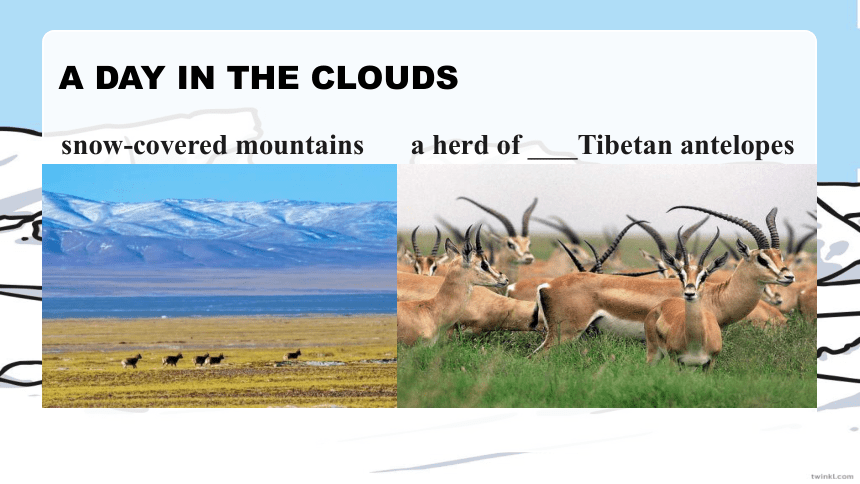
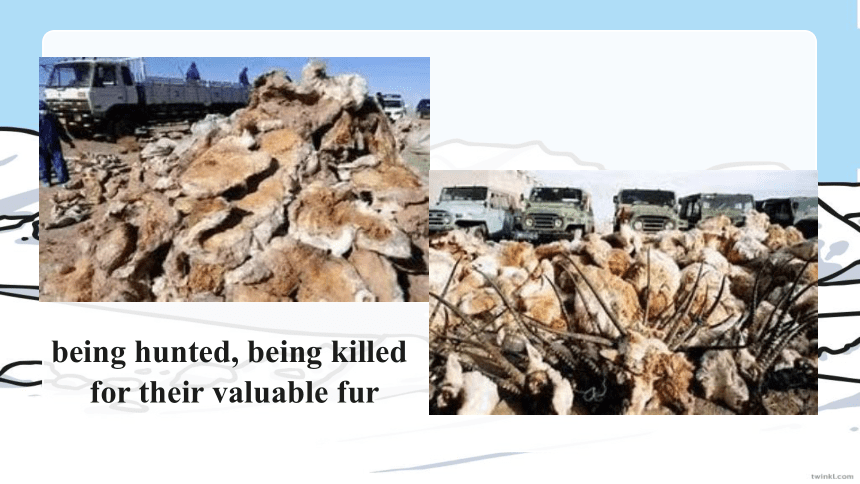
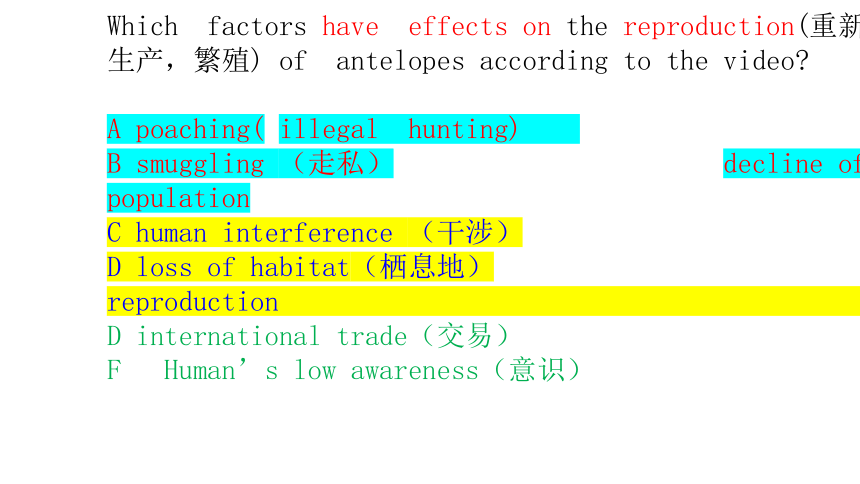


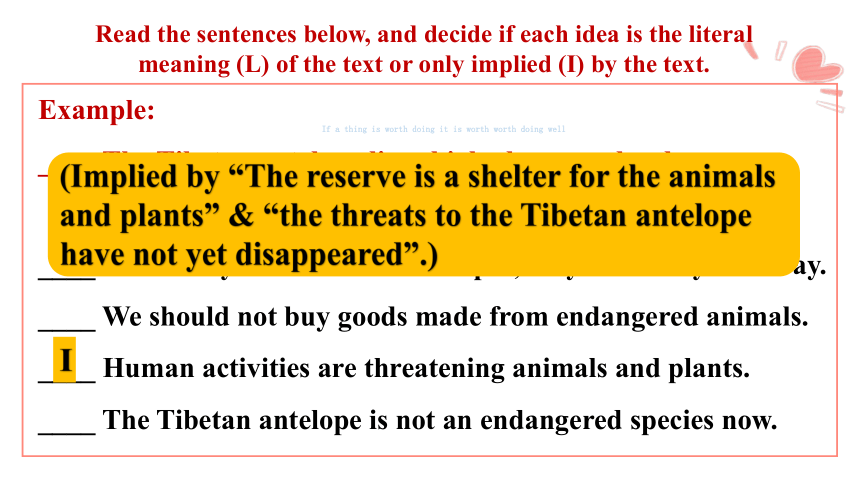
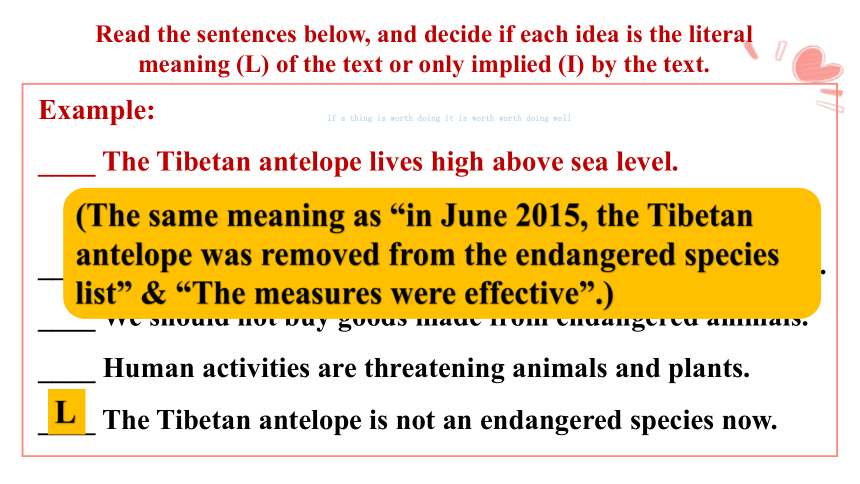
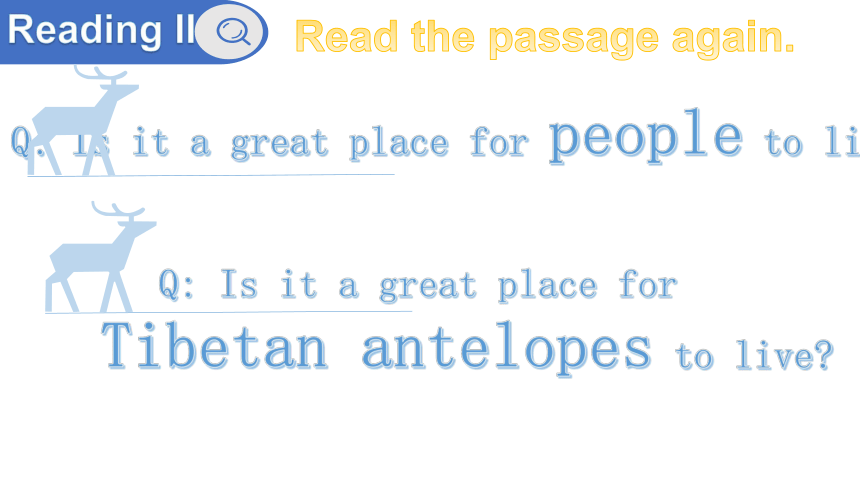
文档简介
(共20张PPT)
A Day
in the Clouds
Unit 2 Reading & Thinking
A DAY IN THE CLOUDS
snow-covered mountains
a herd of Tibetan antelopes
being hunted, being killed
for their valuable fur
Which factors have effects on the reproduction(重新生产,繁殖) of antelopes according to the video
A poaching( illegal hunting)
B smuggling (走私) decline of population
C human interference (干涉)
D loss of habitat(栖息地) reproduction
D international trade(交易)
F Human’s low awareness(意识)
While-reading
Paragraph 5-6
Government
Zhaxi and
other volunteers
placed it under national protection
Bridges and gates were added to let the antelopes move easily
watches over
keeps them safe from attack
Official
participation
Individual
participation
Measures are________
1.The population has recovered
2. The Tibetan antelope was removed from the endangered species list
effective
Results
Careful reading for details.
If a thing is worth doing it is worth worth doing well
In the writer’s opinion what do we need to do
Paragraph 7
We must change our way of life.
We learn to exist in harmony with nature.
In the evening, I drink a cup of tea and watch the stars. I think about the antelopes and what Zhaxi told me. Much is being done to protect wildlife, but if we really want to save the planet, we must change our way of life. Only when we learn to exist in harmony with nature can we stop being a threat to wildlife and to our planet.
Careful reading for details.
If a thing is worth doing it is worth worth doing well
Read the sentences below, and decide if each idea is the literal meaning (L) of the text or only implied (I) by the text.
Example:
____ The Tibetan antelope lives high above sea level.
(this is implied by “The air is thin”.)
____ When they first saw the antelopes, they were very far away.
____ We should not buy goods made from endangered animals.
____ Human activities are threatening animals and plants.
____ The Tibetan antelope is not an endangered species now.
I
(Implied by “The reserve is a shelter for the animals and plants” & “the threats to the Tibetan antelope have not yet disappeared”.)
If a thing is worth doing it is worth worth doing well
Read the sentences below, and decide if each idea is the literal meaning (L) of the text or only implied (I) by the text.
Example:
____ The Tibetan antelope lives high above sea level.
(this is implied by “The air is thin”.)
____ When they first saw the antelopes, they were very far away.
____ We should not buy goods made from endangered animals.
____ Human activities are threatening animals and plants.
____ The Tibetan antelope is not an endangered species now.
(The same meaning as “in June 2015, the Tibetan antelope was removed from the endangered species list” & “The measures were effective”.)
L
If a thing is worth doing it is worth worth doing well
Reading II
Q: Is it a great place for people to live
Q: Is it a great place for
Tibetan antelopes to live
Read the passage again.
The air is thin and we have to rest several times on the short hike from camp. To our left, snow-covered mountains disappear into clouds that seem almost close enough to touch. On the plain in front of us, we can just make out a herd of graceful animals. This is why we’re here—to observe Tibetan antelopes.
Reading II
Q: Is it a great place for people to live
Why
Maybe not.
It’s a place of high altitude.
It’s very cold there.
Implied meaning
Para1
Q: Is it a great place for
Tibetan antelopes to live
Reading II
Yes!
Tibetan antelopes live on the plains of Tibet, Xinjiang, and Qinghai. Watching them move slowly across the green grass, I’m struck by their beauty. I’m also reminded of the danger they are in. They are being hunted, illegally, for their valuable fur.
Para2
Implied meaning:
They have enough ______.
They are living __________.
food
peacefully
Reading II
Do they always have such great environment to live
What was the living situation for the Tibetan antelopes in the 1980s and 1990s
The 1980s and 1990s were bad times for the Tibetan antelope. The population dropped by more than 50 percent. Hunters were shooting antelopes to make profits. Their habitats were becoming smaller as new roads and railways were built.
Para4
Implied meaning:
The Tibetan antelope were _________
because of ______________
and smaller _____________.
in danger
illegal hunting
habitats
①
②
③
④
⑤
⑥
⑦
What is the text type
Journal
what I see
what I hear
what I think
What does the title suggest
16:33
Detailed Reading - What “I” see
Para.1 The air is thin and we have to rest several times on the short hike from camp. To our left, snow-covered mountains disappear into clouds that seem almost close enough to touch. On the plain in front of us, we can just make out a herd of graceful animals. This is why we’re here — to observe Tibetan antelopes.
Why did the writer visit Tibet
16:33
A day in Hoh Xil
Imagining that you were a volunteer in the Tibetan antelope reserve, what is your daily life like
play with them
feed them
keep them safe from cars
You are going to deliver a speech to promote public knowledge or awareness of wildlife protection.
As time goes by, more and more wild animals become endangered and some have already died out.
One of the major reason is that________________________. At the same time, ________________. Besides,______________________.
All in all, human beings are mainly responsible for the present situation. In order to live harmoniously with animals, everyone of us ____________________________.
Guessing
Strong
What do you think of antelopes in this picture
living
…
How do you feel about this picture
angry
afraid
…
Why did this happen
If a thing is worth doing it is worth worth doing well
Guessing
Actually, they suffer some attacks, because of their valuable fur. For example, hunters shoot them and use their furs to make profits.
What can we do to change this situation
law
National natural reserves
If a thing is worth doing it is worth worth doing well
Detailed Reading - A day in the clouds
Para.3 My guide is Zhaxi, a village from Changtang. He works at the Changtang National Nature Reserve. The reserve is a shelter for the animals and plants of northwestern Tibet. To Zhaxi, the land is sacred and protecting the wildlife is a way of life. “We’re not trying to save the animals,” he says. “Actually, we’re trying to save ourselves.”
What is Zhaxi’s opinion
16:33
Detailed Reading - What “I” think
Para.7 In the evening, I drink a cup of tea and watch the stars. I think about the antelopes and what Zhaxi told me. Much is being done to protect wildlife, but if we really want to save the planet, we must change our way of life. Only when we learn to exist in harmony with nature can we stop being a threat to wildlife and to our planet.
What do “I” think
16:33
A Day
in the Clouds
Unit 2 Reading & Thinking
A DAY IN THE CLOUDS
snow-covered mountains
a herd of Tibetan antelopes
being hunted, being killed
for their valuable fur
Which factors have effects on the reproduction(重新生产,繁殖) of antelopes according to the video
A poaching( illegal hunting)
B smuggling (走私) decline of population
C human interference (干涉)
D loss of habitat(栖息地) reproduction
D international trade(交易)
F Human’s low awareness(意识)
While-reading
Paragraph 5-6
Government
Zhaxi and
other volunteers
placed it under national protection
Bridges and gates were added to let the antelopes move easily
watches over
keeps them safe from attack
Official
participation
Individual
participation
Measures are________
1.The population has recovered
2. The Tibetan antelope was removed from the endangered species list
effective
Results
Careful reading for details.
If a thing is worth doing it is worth worth doing well
In the writer’s opinion what do we need to do
Paragraph 7
We must change our way of life.
We learn to exist in harmony with nature.
In the evening, I drink a cup of tea and watch the stars. I think about the antelopes and what Zhaxi told me. Much is being done to protect wildlife, but if we really want to save the planet, we must change our way of life. Only when we learn to exist in harmony with nature can we stop being a threat to wildlife and to our planet.
Careful reading for details.
If a thing is worth doing it is worth worth doing well
Read the sentences below, and decide if each idea is the literal meaning (L) of the text or only implied (I) by the text.
Example:
____ The Tibetan antelope lives high above sea level.
(this is implied by “The air is thin”.)
____ When they first saw the antelopes, they were very far away.
____ We should not buy goods made from endangered animals.
____ Human activities are threatening animals and plants.
____ The Tibetan antelope is not an endangered species now.
I
(Implied by “The reserve is a shelter for the animals and plants” & “the threats to the Tibetan antelope have not yet disappeared”.)
If a thing is worth doing it is worth worth doing well
Read the sentences below, and decide if each idea is the literal meaning (L) of the text or only implied (I) by the text.
Example:
____ The Tibetan antelope lives high above sea level.
(this is implied by “The air is thin”.)
____ When they first saw the antelopes, they were very far away.
____ We should not buy goods made from endangered animals.
____ Human activities are threatening animals and plants.
____ The Tibetan antelope is not an endangered species now.
(The same meaning as “in June 2015, the Tibetan antelope was removed from the endangered species list” & “The measures were effective”.)
L
If a thing is worth doing it is worth worth doing well
Reading II
Q: Is it a great place for people to live
Q: Is it a great place for
Tibetan antelopes to live
Read the passage again.
The air is thin and we have to rest several times on the short hike from camp. To our left, snow-covered mountains disappear into clouds that seem almost close enough to touch. On the plain in front of us, we can just make out a herd of graceful animals. This is why we’re here—to observe Tibetan antelopes.
Reading II
Q: Is it a great place for people to live
Why
Maybe not.
It’s a place of high altitude.
It’s very cold there.
Implied meaning
Para1
Q: Is it a great place for
Tibetan antelopes to live
Reading II
Yes!
Tibetan antelopes live on the plains of Tibet, Xinjiang, and Qinghai. Watching them move slowly across the green grass, I’m struck by their beauty. I’m also reminded of the danger they are in. They are being hunted, illegally, for their valuable fur.
Para2
Implied meaning:
They have enough ______.
They are living __________.
food
peacefully
Reading II
Do they always have such great environment to live
What was the living situation for the Tibetan antelopes in the 1980s and 1990s
The 1980s and 1990s were bad times for the Tibetan antelope. The population dropped by more than 50 percent. Hunters were shooting antelopes to make profits. Their habitats were becoming smaller as new roads and railways were built.
Para4
Implied meaning:
The Tibetan antelope were _________
because of ______________
and smaller _____________.
in danger
illegal hunting
habitats
①
②
③
④
⑤
⑥
⑦
What is the text type
Journal
what I see
what I hear
what I think
What does the title suggest
16:33
Detailed Reading - What “I” see
Para.1 The air is thin and we have to rest several times on the short hike from camp. To our left, snow-covered mountains disappear into clouds that seem almost close enough to touch. On the plain in front of us, we can just make out a herd of graceful animals. This is why we’re here — to observe Tibetan antelopes.
Why did the writer visit Tibet
16:33
A day in Hoh Xil
Imagining that you were a volunteer in the Tibetan antelope reserve, what is your daily life like
play with them
feed them
keep them safe from cars
You are going to deliver a speech to promote public knowledge or awareness of wildlife protection.
As time goes by, more and more wild animals become endangered and some have already died out.
One of the major reason is that________________________. At the same time, ________________. Besides,______________________.
All in all, human beings are mainly responsible for the present situation. In order to live harmoniously with animals, everyone of us ____________________________.
Guessing
Strong
What do you think of antelopes in this picture
living
…
How do you feel about this picture
angry
afraid
…
Why did this happen
If a thing is worth doing it is worth worth doing well
Guessing
Actually, they suffer some attacks, because of their valuable fur. For example, hunters shoot them and use their furs to make profits.
What can we do to change this situation
law
National natural reserves
If a thing is worth doing it is worth worth doing well
Detailed Reading - A day in the clouds
Para.3 My guide is Zhaxi, a village from Changtang. He works at the Changtang National Nature Reserve. The reserve is a shelter for the animals and plants of northwestern Tibet. To Zhaxi, the land is sacred and protecting the wildlife is a way of life. “We’re not trying to save the animals,” he says. “Actually, we’re trying to save ourselves.”
What is Zhaxi’s opinion
16:33
Detailed Reading - What “I” think
Para.7 In the evening, I drink a cup of tea and watch the stars. I think about the antelopes and what Zhaxi told me. Much is being done to protect wildlife, but if we really want to save the planet, we must change our way of life. Only when we learn to exist in harmony with nature can we stop being a threat to wildlife and to our planet.
What do “I” think
16:33
